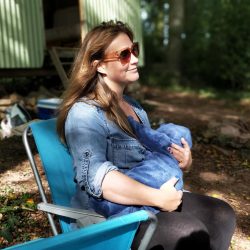The idea of Kegel exercises is probably not a new one to most women, especially new moms. Discussions about the “pelvic floor” have become much more common over the last several years, along with the benefits of Kegels for all women. However, many may not understand the real importance of paying attention to either until, well, they “need” to. The good news is that doing Kegels in your postpartum period is an easy practice and you can improve and strengthen your pelvic floor after birth. Here’s what you need to know to get started.
What is the pelvic floor and why do I need to be aware of it?
“The pelvic floor muscles work like a hammock to support the pelvic organs, including the uterus, bladder and rectum” according to Mayo Clinic. Because of the strain these muscles experience when a baby is growing inside you, they can weaken as a result of pregnancy. They are further stretched during childbirth, causing a bit of rebuilding in the following months. Because of the stress they undergo during pregnancy and birth some women experience leaking when they attempt to start up their post-pregnancy workouts or even when they least expect it, such as sneezing.
Learn more: What You Should Know About Your Pelvic Floor
Is my pelvic floor impacted if I have a C-section?
While some pelvic floor issues such as incontinence occur at slightly lower rates among women who have cesarean sections, because of the strain that a growing baby puts on these muscles, you will likely notice a difference after giving birth regardless of how you deliver. This is why using Kegels after birth is so important for all women.
How soon can I do Kegels postpartum?
You can start incorporating Kegels into your birth recovery immediately. In fact, the exercises help significantly with postpartum issues such as leaking and incontinence. There is no need to wait to begin.
Getting started with Kegels after birth
Whether or not you are new to the practice, you may want to review the most helpful way to do Kegels postpartum so that it supports your recovery and most benefits your postpartum pelvic floor.
Here’s an easy routine to follow:
- The best way to begin Kegels after birth is to practice stopping the flow when you urinate. Practice this a few times, making sure not to clench your abdomen, glute muscles, or anus at the same time.
- Once you get used to what muscle needs to be contracted, simply make sure to practice three times each day, contracting the muscle for ten seconds at a time.
- Work up to three sets of 10-20 contractions a day.
A trick to remembering to do your Kegels postpartum is to do them while you are feeding your baby. You are sure to get in three sessions a day that way!
Whatever you find that works best for you, make sure that you figure out how to make it a habit. Doctors recommend that Kegels be done for a lifetime for best results. Seem daunting? Don’t worry – you will soon come to find that it becomes second nature. A Kegels routine is nothing to stress over – short sessions just three times a day will bring noticeable results.
Bonus tip: Kegels during sex
A couple’s sex life can sometimes need a bit of a refresher after a baby is born and practicing Kegels is a great way to add a bit of fun to your new habit. Start with short pulses while in bed with your partner and go from there. After all; it’s sex, it is meant to be fun and for you to figure out what works for you.
Note: Kegels are not a solution to all pelvic floor issues
Kegels after birth will help all women in one way or another. However, they will not solve all problems that women face with their postpartum pelvic floor. If you are still experiencing symptoms or have concerns about your recovery after sex weeks, discuss them with your doctor at your six to eight-week checkup.
Note: A physical therapist trained in Pelvic Floor PT can help you rehabilitate your pelvic floor
Some physical therapists receive special training in pelvic floor rehabilitation. These experts can help you rehabilitate and strengthen your pelvic floor and your core. They can also help you spot fairly common post-pregnancy issues such as diastasis recti.
Learn more about your postpartum recovery:
Pelvic Floor Recovery and Your Postpartum Plan
Breaking the myth of “bouncing back” and resetting pregnancy and postpartum fitness expectations


